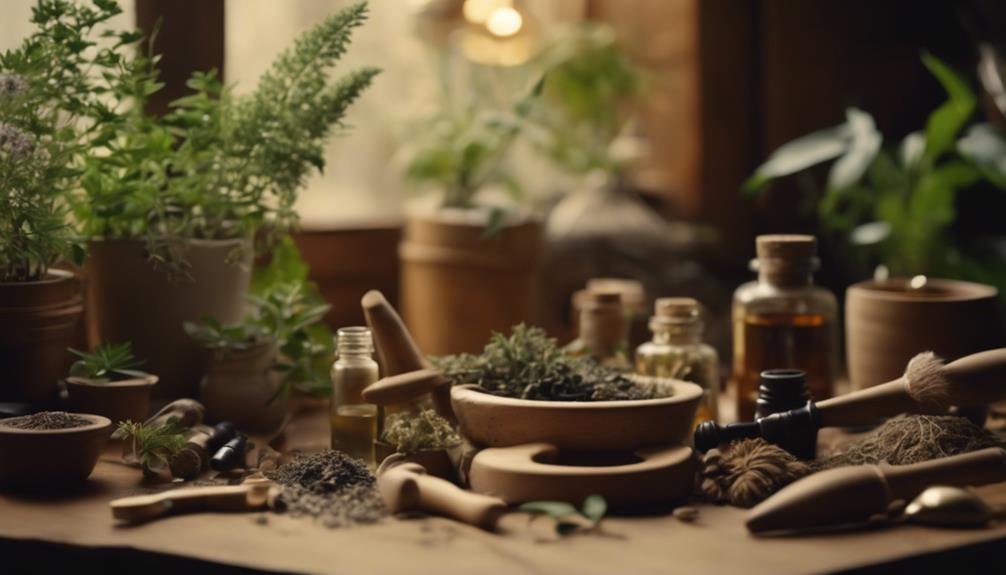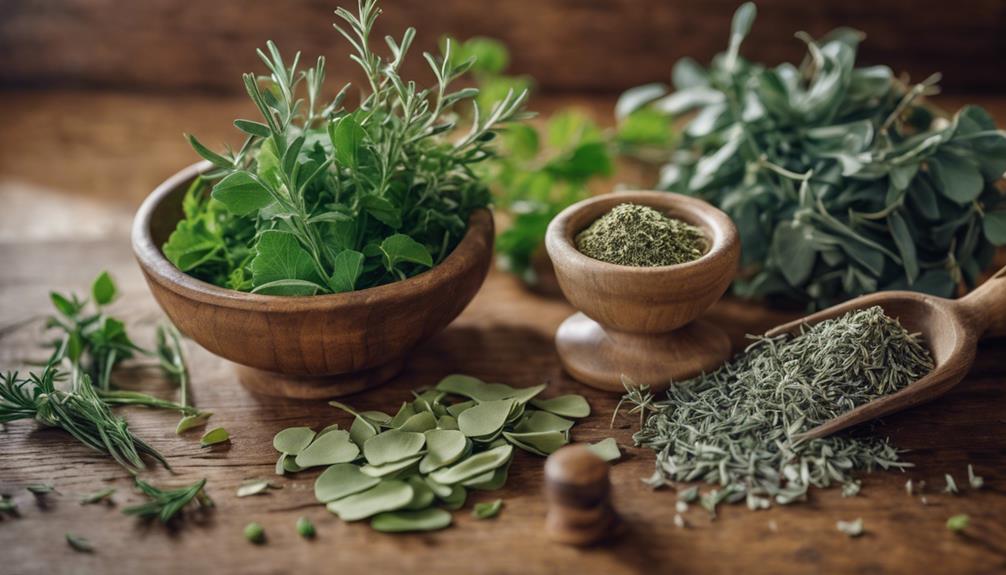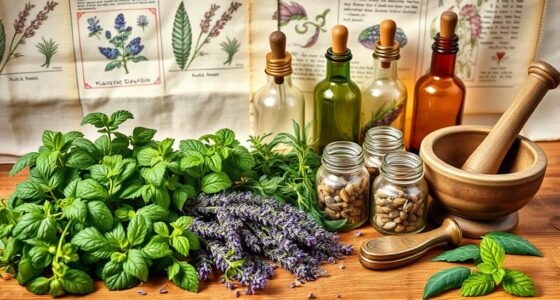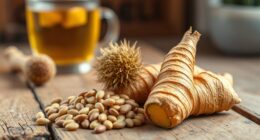We're considering a career in herbalism, but we're wondering how much it'll set us back. The cost of herbalism education varies widely, ranging from a few hundred dollars to $25,000 or more, depending on the type of program, education level, and focus areas we choose. Full-time programs can cost $5,000 to $15,000 per year, while distance learning programs range from $400 to $2,500. Certification fees add to the total, with exam fees ranging from $200 to $500. As we explore the world of herbalism, we'll find that the costs add up, but the rewards can be worth it. There's more to discover about the path to becoming a certified herbalist.
Key Takeaways
• Herbalism education costs vary from $400 to $25,000, depending on the program, education level, and focus areas.
• Full-time herbal medicine school tuition ranges from $5,000 to $15,000 per year, while distance learning programs cost $400 to $2,500.
• Naturopathic medical schools cost $20,000 to $25,000 annually, leading to certifications like Certified Herbalist (CH) or Registered Herbalist (RH).
• Exam and testing fees range from $200 to $500, and are non-refundable, varying by program.
• Additional costs include herbs and equipment expenses, which vary based on the type needed, with herbal remedies ranging from a few dollars to expensive rare or exotic ones.
Types of Herbalism Education
Exploring the field of herbalism, we find that our educational journey can take various paths, each with its unique set of costs and requirements.
We can choose to enroll in full-time programs, which can cost between $5,000 to $15,000 per year. Alternatively, we can opt for distance learning programs, which are more affordable, ranging from $400 to $2,500.
For those interested in becoming naturopathic physicians, a bachelor's degree and a 4-year Doctor of Naturopathic Medicine program are required. The American Herbalists Guild recommends a minimum of 1600 hours of study to become a certified herbalist.
Herbal medicine education can lead to various certifications, including the Certified Herbalist (CH) or Registered Herbalist (RH) titles. Regardless of the path we choose, researching and understanding the costs and requirements involved is crucial. By doing so, we can make informed decisions about our educational pursuits in herbal medicine.
Average Cost of Herbalism Studies

Understanding the average cost of herbalism studies is crucial as we embark on our herbalism journey. The cost of herbalism studies can vary widely, ranging from a few hundred dollars to a staggering $25,000, depending on the program and level of education we choose.
The cost of herbalism studies can vary based on the institution, program length, and specific focus areas within herbal medicine. For instance, distance learning programs typically cost between $400 to $2,500, while full-time herbal medicine school can range from $5,000 to $15,000 per year.
Naturopathic medical schools, which also include herbalism training, can cost $20,000 to $25,000 per year on average. Health professionals and aspiring herbalists should consider their preferred payment options and budget accordingly.
Researching and comparing costs is crucial to find the program that best fits our needs and budget. With a clear understanding of the costs involved, we can make an informed decision about our herbalism education.
Herbalism Certification Fees

As we explore the costs associated with herbalism certification, we need to take into account the program tuition costs, which can vary widely depending on the program and level of certification.
We'll also examine the exam and testing fees, which can add up quickly, and discuss how these costs can impact our decision to pursue certification.
Program Tuition Costs
When pursuing herbalism certification, we need to bear in mind the program tuition costs, which can vary widely depending on the type of program and institution.
For instance, distance learning programs can range from $400 to $2,500. If we're looking at full-time herbal medicine school, tuition typically ranges from $5,000 to $15,000 per year.
Meanwhile, naturopathic medical schools can be quite pricey, with costs ranging from $20,000 to $25,000 per year for a 4-year Doctor of Naturopathic Medicine program. Even courses like the Foundations of Herbalism have a full cost of $675 USD.
It's crucial to take into account all expenses, including additional fees for books and equipment, when budgeting for our herbalism education. We should factor these costs into our overall budget to be prepared for the financial investment required to achieve our certification goals.
Exam and Testing
Herbalism certification exam fees, an important consideration in our pursuit of certification, typically range from $200 to $500. As we work towards becoming certified herbalists, it's vital to factor in these costs to make sure we're prepared for the financial investment.
Additional testing fees may apply for specific herbalism certification levels or specialty exams, so it's important to research the specific requirements for our desired certification. Some herbalism certification programs include exam fees in the overall program cost, while others require separate payment.
Here are three key points to keep in mind when it comes to herbalism certification exam fees:
- Exam fees are non-refundable: Make sure we're ready for the test before scheduling.
- Fees contribute to maintaining standards: Our exam fees help ensure the credibility of herbalism professionals.
- Fees vary by program: Research the specific costs associated with our chosen certification program.
Tuition for Herbalism Courses

As we explore the costs associated with becoming an herbalist, we're taking a closer look at the tuition fees for herbalism courses.
We'll examine the varying prices of online courses, in-person classes, and certification programs to give you a clear understanding of what to expect.
From online courses starting at $26.25 to naturopathic medical schools costing upwards of $25,000 per year, we'll break down the costs to help you make informed decisions.
Online Course Prices
Taking the first step into the world of herbalism often involves investing in online courses, with tuition fees ranging from $400 to $2,500 for distance learning programs. We're not just dipping our toes into the world of herbalism; we're diving in headfirst, and that requires a financial commitment.
As we explore the world of online herbalism courses, we're met with varying price points that can be overwhelming.
To give you a better idea of what to expect, here are a few examples of online course prices:
- Tiered pricing options: Some courses offer tiered pricing, ranging from $26.25 to $105.
- Foundations of Herbalism: This detailed course costs a total of $675.
- Distance learning programs: These programs can cost anywhere from $400 to $2,500.
As we navigate the world of herbalism, it's crucial to understand the costs involved. By knowing what to expect, we can make informed decisions about our educational journey.
In-Person Class Costs
We're now considering a more immersive approach to herbalism education, opting for in-person classes that can cost between $5,000 to $15,000 per year, depending on the school and program. This significant investment provides hands-on learning, direct access to instructors, and a more thorough understanding of herbalism.
Naturopathic medical schools, which often offer herbalism education, can be even more expensive, ranging from $20,000 to $25,000 per year. However, full-time herbalism school tuition varies widely based on factors like curriculum, location, and program duration.
While in-person classes offer a rich learning experience, they require a substantial financial commitment. Researching and comparing costs is crucial, weighing the benefits of in-person education against online or distance learning options, which can be more affordable.
Certification Program Fees
We pay anywhere from $5,000 to $15,000 per year for herbalism certification programs, which can be a significant upfront investment in our education. This cost varies depending on the institution, program duration, and type of certification we're seeking. Some naturopathic medical schools for herbalism can cost between $20,000 to $25,000 annually, while distance learning programs may range from $400 to $2,500.
To give you a better idea, here are some key points to take into account:
- Program duration: Some certification programs require 1600 hours of study, which can span several months or even years.
- Tuition variations: Tuition for individual herbalism modules or courses can vary based on the institution and program duration.
- Naturopathic programs: These programs often have higher tuition fees, ranging from $20,000 to $25,000 annually.
It's essential to research and compare prices to find the best fit for our budget and educational goals.
Online Herbalism Program Costs

Understanding the cost structure of the online herbalism program at the Institute for Health Professionals is crucial. This program is broken down into three modules, each priced at $999, totaling $2,997 for the entire program, excluding potential additional fees for books and equipment.
Each module has a duration of three months, making the program span over a period of nine months. It's worth noting that this program isn't eligible for Federal Financial Aid and is classified as a noncredit CEU program.
Additionally, we should take into account that the program's cost is divided into the three modules, making it more financially manageable. However, we should also consider factoring in the extra expenses for books and equipment to have a comprehensive understanding of the total cost.
Herbs and Equipment Expenses

When we explore the world of herbalism, it's important to take into account the costs linked to the herbs and equipment required for practice. The cost of herbalism can vary greatly, depending on the type of herbs and equipment needed. Herbal remedies can range from a few dollars for basic herbs to more expensive rare or exotic herbs.
Some essential equipment expenses include:
- Mortar and pestle: an essential tool for grinding and mixing herbs
- Herb grinders: for efficient and precise herb processing
- Scales: for accurate measurement of herbs and ingredients
High-quality equipment may cost more upfront, but it can enhance the effectiveness of herbal preparations. Budgeting for herbs and equipment is essential for practicing herbalism effectively and efficiently.
Herbalism Education Duration

Pursuing a career in herbalism requires a significant investment of time and resources. Our educational journey can span several years and thousands of hours. We're not just talking about a weekend workshop or a few online courses – we're talking about a serious commitment to learning.
On average, becoming a certified herbalist requires around 1600 hours of study. That's a lot of time, effort, and dedication. If we choose to pursue a career as a naturopathic physician, we're looking at a bachelor's degree plus a 4-year Doctor of Naturopathic Medicine program. We need to be prepared to put in the time and effort required to gain the knowledge and skills necessary to succeed in this field.
With distance learning programs ranging from a few hundred to several thousand dollars, and full-time herbal medicine schools costing upwards of $5,000 to $15,000 per year, it's clear that herbalism education is a significant investment. But for those of us who are passionate about natural health and wellness, it's an investment worth making.
Herbal Medicine School Fees

We're looking at a significant upfront investment, with full-time herbal medicine schools costing between $5,000 to $15,000 per year. This is a substantial amount, especially considering that most programs require around 1600 hours of study to earn certification. However, it's worth noting that distance learning programs can be a more affordable option, ranging from $400 to $2,500.
Here are some key points to keep in mind when contemplating herbal medicine school fees:
- Full-time programs: $5,000 to $15,000 per year
- Distance learning: $400 to $2,500
- Naturopathic medical schools: $20,000 to $25,000 per year (for those who want to pursue a more thorough education)
It's essential to weigh these costs against our goals and motivations for pursuing a career in herbalism. While the upfront investment may seem challenging, it's important to take into account the long-term benefits of a fulfilling career in this field.
Practicing Herbalist Salary Range

As herbalists, our earning potential varies widely, with average salaries ranging from $30,000 to $80,000 per year, depending on factors like experience, location, and specialization.
We've found that our salaries are influenced by multiple factors, including our level of experience, employer, and area of specialization within herbalism.
Entry-level herbalists typically earn around $30,000 annually, while those with advanced certifications or extensive experience can earn up to $80,000.
We've noticed that herbalists working in healthcare settings or with private practices tend to earn higher salaries compared to those in retail or educational roles.
Additionally, our location plays a significant role in determining our salary, with urban areas generally offering higher pay than rural areas.
Cost of Herbalism Conferences

We often invest in our professional development by attending herbalism conferences, which can be a costly endeavor. As herbalism enthusiasts, we acknowledge the importance of staying updated on the latest research, networking with fellow practitioners, and learning from industry experts. However, the cost of attending these conferences can be a significant burden.
Here are some expenses to take into account when attending a herbalism conference:
- Registration fees: These can range from $100 to $500, depending on the conference and our level of registration (e.g., early bird, student, or professional).
- Travel and accommodation: We need to factor in the cost of flights, hotels, and meals, which can add up quickly.
- Optional workshops and activities: These extras can enhance our conference experience, but they come at an additional cost.
To make attending a herbalism conference more affordable, we can explore virtual events, early bird discounts, group rates, or scholarship opportunities. By being mindful of these expenses, we can make informed decisions about our professional development and budget accordingly.
Frequently Asked Questions
How Much Does It Cost to Learn Skinning?
We're curious about the cost of learning skinning in herbalism.
Surprisingly, there isn't a specific course or program dedicated solely to skinning in herbalism. Skinning is a process in herbalism that involves harvesting and preparing plant material, but it's not a standalone course.
Herbalism programs typically cover a broader range of topics, including skinning, and their costs vary widely, from $400 to $25,000 per year, depending on the program and institution.
Conclusion
As we explore the world of herbalism, the costs can add up, but the rewards are worth it. From tuition fees to certification costs, the investment can range from a few hundred to several thousand dollars. But for those passionate about harnessing nature's remedies, the pursuit of knowledge is priceless.
Like a tender shoot sprouting from the earth, our understanding of herbalism grows, nourished by the seeds of education and experience.










